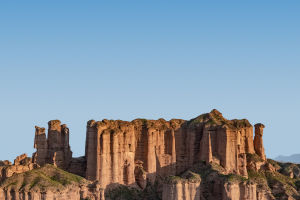A desert oasis is a natural wonder that can be found in arid regions around the world.
These oases are created when underground springs or streams surface and create a small body of water in the middle of a desert. These bodies of water can range in size from small ponds to large lakes, and they provide a vital source of water for the surrounding plants and animals.
One of the most famous examples of a desert oasis is the Siwa Oasis in Egypt. This oasis is located in the middle of the Western Desert and is known for its palm trees, olive groves, and freshwater springs. It has been inhabited for thousands of years, and its natural beauty has attracted visitors from around the world.
Desert oases are characterized by their unique ecosystems, which are adapted to the harsh conditions of the surrounding desert. The plants and animals that live in these oases have developed specialized adaptations that allow them to survive in a hot and dry environment.
One of the most important adaptations for plants in desert oases is their ability to store water. Many of the plants in these oases have fleshy leaves or stems that can store water for long periods of time. These plants also have deep root systems that allow them to tap into the underground water sources that feed the oasis.
The animals that live in desert oases also have unique adaptations that allow them to survive in this harsh environment. Many of these animals are nocturnal, meaning that they are active at night when the temperatures are cooler. They also have specialized methods for conserving water, such as the ability to concentrate their urine to minimize water loss.
In addition to their unique ecosystems, desert oases are also known for their cultural significance. Many of these oases have been inhabited for thousands of years, and they have played an important role in the development of human civilizations in these regions.
For example, the Siwa Oasis in Egypt has been inhabited since ancient times, and it was an important center of commerce and culture in the region. The oasis was also an important pilgrimage site for the ancient Egyptians, who came to worship the god Amun at the Temple of the Oracle.
Today, many desert oases are popular tourist destinations, offering visitors a glimpse into the unique ecosystems and cultural heritage of these regions. Visitors can explore the palm groves, swim in the cool waters of the oasis, and learn about the history and culture of the local people.
Despite their beauty and cultural significance, desert oases face a number of challenges in the modern world. Climate change, overuse of water resources, and pollution are all threats to these delicate ecosystems. As a result, many conservation efforts are underway to protect these important natural wonders.
A desert oasis is a unique and fascinating natural wonder that offers a glimpse into the beauty and resilience of life in the desert. From their specialized ecosystems to their rich cultural heritage, desert oases are a testament to the power of nature and the ingenuity of human beings. Whether you are a nature lover, a history buff, or simply curious about the world around you, a visit to a desert oasis is sure to be a memorable and enriching experience.


